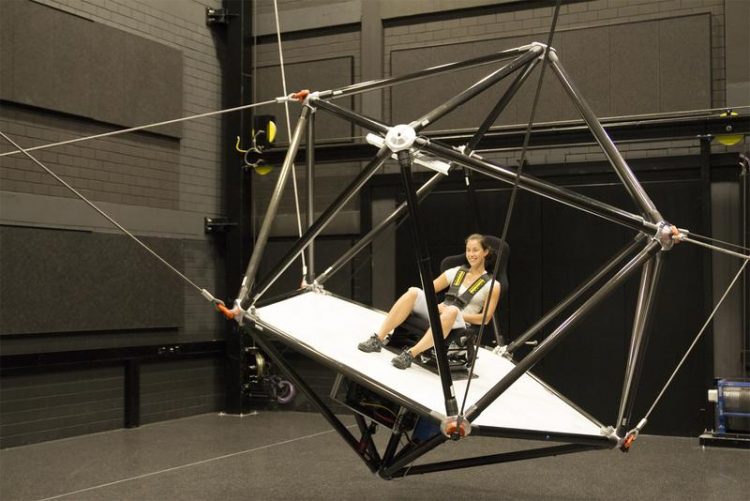Cable-driven parallel robots – Motion simulation in a new dimension

The cabine design, here in minimal configuration, is modular and easily adjustable. Source: Fraunhofer IPA, Photo: Philipp Miermeister
To date, cable robots have been used in production environments, where they meet high requirements. The systems surpass conventional industrial robots in size and pay- load by between one and two orders of magnitude. The end effector can be freely moved with high accuracy by up to eight cables and winches. Based on this technology and in a world first, the idea of a cable-driven motion simulator has now been realized under the lead of Professor Heinrich Bülthoff from MPI for Biological Cybernetics.
Technical innovations
In the cable-driven simulator, the motion of the simulator cabin is controlled by eight unsupported steel cables attached to winches. In contrast to conventional motion simulators, the use of cables makes it possible to reduce the moving mass and to scale the workspace to any required size. A total drive power of 348 kW allows the cabin to accelerate at 1.5 times gravitational acceleration along freely programmable paths inside a 5 x 8 x 5 m³ workspace.
In addition, the cables can be reattached in under an hour to enable the simulator to be adapted to different cabins and thus used for a range of scenarios. During the two-year collaboration between both Institutes, Philipp Miermeister, a member of Fraunhofer IPA’s Cable Robotics working group headed by Junior Professor Andreas Pott, has contributed much know-how to driving forward the design and realization of the simulator.
The scientists have not only implemented the control algorithms, but also developed a lightweight yet rugged carbon fibre cabin capable of withstanding the high dynamic loads during operation. Made entirely from carbon fibre tubes, the cabin frame maximizes the usable cabin volume with a diameter of 260 cm for projection surfaces and cockpit instrumentation. This allows it to be used for highquality video projections and realistic operator interfaces.
At the same time, the light 80 kg frame is capable of accelerating at high speed while also withstanding high forces, because, in operation, the cables pull on the outer structure with up to 1.5 tonnes. Its large workspace and dynamic capabilities make the simulator suitable for a wide spectrum of VR (virtual reality) applications, including driving/flight simulation as well as investigation of basic perception processes in humans.
“This simulator offers us entirely new possibilities for studying motion perception with possible applications in neurological research into balance disorders,” says Professor Bülthoff, who is a long-time perception researcher.
Successful collaboration
There is a history of collaboration between the Fraunhofer and Max Planck Institutes.
“With the cable-driven simulator, the scientists from both Institutes have once again demonstrated how the combination of basic research and industry-oriented technology development can lead to innovative products,” underlines Professor Thomas Bauernhansl, Institute Director at Fraunhofer IPA.
Maiden journey of the cable-driven simulator
During a welcoming reception at the Driving Simulation Conference & Exhibition (DSC2015), the scientists will unveil the cable robot to a wider audience. One of Europe’s leading conferences in the field of driving simulation, DSC is being held in Germany for the first time. Taking part alongside MPI are the Mercedes-Benz Sindelfingen plant of Daimler AG as well as the Research Institute of Automotive Engineering and Vehicle Engines (FKFS) from the University of Stuttgart. Coupled with an exhibition, the conference attracts experts from research and industry. Journalists are welcome to attend the reception at 7 p.m. on 16 September; those wishing to attend are requested to register: presse-kyb@tuebingen.mpg.de
Information in brief
Conference: Driving Simulation Conference & Exhibition (DSC2015)
When: 16 to 18 September 2015
Where: Tübinger Kupferbau
Organizer: Paolo Pretto, Max Planck Institute for Biological Cybernetics, in cooperation with Renault and France’s Grande École Arts et Métiers ParisTech
Press event: As part of DSC2015, a reception will be held at 7 p.m. on 16 September, at which the simulators of MPI for Biological Cybernetics will be available for viewing. If interested, please register giving your name, contact details and medium by email to: pressekyb@ tuebingen.mpg.de
Contact Partner
Philipp Miermeister | Phone +49 711 970-1114 | philipp.miermeister@ipa.fraunhofer.de | Fraunhofer Institute for Manufacturing Engineering and Automation IPA | www.ipa.fraunhofer.de
Media Contact
All latest news from the category: Interdisciplinary Research
News and developments from the field of interdisciplinary research.
Among other topics, you can find stimulating reports and articles related to microsystems, emotions research, futures research and stratospheric research.
Newest articles

NASA: Mystery of life’s handedness deepens
The mystery of why life uses molecules with specific orientations has deepened with a NASA-funded discovery that RNA — a key molecule thought to have potentially held the instructions for…

What are the effects of historic lithium mining on water quality?
Study reveals low levels of common contaminants but high levels of other elements in waters associated with an abandoned lithium mine. Lithium ore and mining waste from a historic lithium…

Quantum-inspired design boosts efficiency of heat-to-electricity conversion
Rice engineers take unconventional route to improving thermophotovoltaic systems. Researchers at Rice University have found a new way to improve a key element of thermophotovoltaic (TPV) systems, which convert heat…



